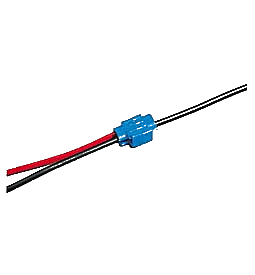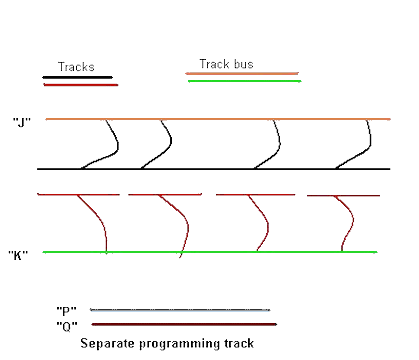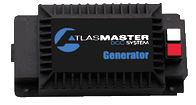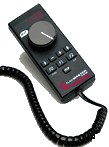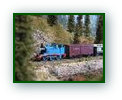It would be ideal to use the same color wire for bus and feeders but as long as you use some convention to keep it all straight it will work ok.
The early photo to the left shows the power bus (black and white wires) and the accessory bus (red and green wires).
You can also see the black terminal strips used to organize the wiring. The red and black feeders will be connected to the black and white wires using "tap-in" snap connectors (below).
Shown below is a simple diagram of the power bus and feeders. "J" and "K" are the terminals on the DCC Commander. Also shown is the connection to the program track, "P and "Q". Any other DCC system would be similar.
The Commander is powered by an Atlas "Generator" AC transformer.
We use the Atlas Commander DCC system with two HandCommand walk-around throttles.
Now for a little discussion of the wiring for the SJSRR, or almost any other using DCC. Wiring for DCC is very simple, I think, compared to wiring for DC "block control" where the movement of trains around the layout is
controlled partly by flipping toggles to transfer "cab" (throttle) power the appropriate portion of the layout where your particular train (and no other) will be running. With DCC (Digital Command Control), block control is not necessary or even applicable. You just set your throttle (cab) to the address of the train that you wish to control and then you can run your train anywhere on the layout regardless of whether or not other trains are running in the same vicinity. Of course you don't want to collide with another train (??) so you must be aware of the other traffic. It's been said many times that "DCC lets you run the trains, not the track."
Two main elements of the wiring are the power bus and the track feeders.
Typically the power (or track) bus is 14AWG wire. The feeders from the bus to the track are usually 22AWG to 18AWG wire. I used 18ga (AWG) solid in red and black to help keep the connections straight.
The power bus runs the entire length of the layout and feeders are place every few feet (3' works well). The main concern with the feeder spacing is to ensure that all sections of track have a good connection to the bus. With DCC the track will carry the DCC "command" signals as well as the power to run the loco motors, so good connections, clean track and adequately sized
wire are important to satisfactory operation.

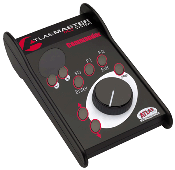
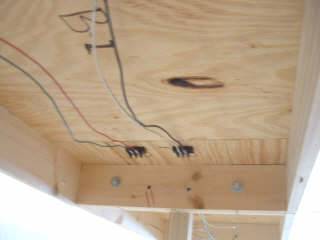
Copyrightę 2001 - 2013 Jack W. Murray, Jr.
All rights reserved
